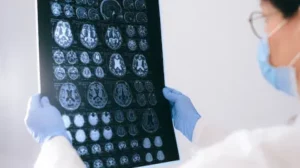Could an arthritis drug unlock lasting relief from epilepsy and seizures? UW–Madison researchers see promising results in mice.
Featuring the work of Avtar Roopra, CURE Epilepsy grantee. Article published by University of Wisconsin-Madison.
A drug typically prescribed for arthritis halts brain-damaging seizures in mice with epilepsy, according to researchers in the lab of Avtar Roopra, PhD at the University of Wisconsin–Madison. The drug, called tofacitinib, also restores short-term and working memory lost to epilepsy in the mice and reduces inflammation in the brain caused by the disease. If the drug proves viable for people with epilepsy, it would be the first to provide lasting relief from seizures even after people stop taking it.
On their way to identifying tofacitinib’s potential in epilepsy, researchers sifted through thousands of genes expressed in millions of cells in the brains of mice with and without epilepsy. They found a protein called STAT3, key to a cell signaling pathway called JAK, at the center of activity in the seizure-affected mouse brains. Meanwhile, researchers had also unearthed a study of tens of thousands of arthritis patients in Taiwan that described diseases associated with arthritis. It turns out, epilepsy was much more common among those arthritis patients than people without arthritis — but surprisingly less common than normal for the arthritis patients who had been taking anti-inflammatory drugs for more than five-and-a-half years.
“If you’ve had rheumatoid arthritis for that long, your doctor has probably put you on what’s called a JAK-inhibitor, a drug that’s targeting this signaling pathway we’re thinking is really important in epilepsy,” says Olivia Hoffman, lead author of the study and a postdoctoral researcher in Roopra’s lab.
The UW researchers ran a trial with their mice, dosing them with the JAK-inhibitor tofacitinib following the administration of a brain-damaging drug that puts the mice on the road to repeated seizures. In the lab mice, there’s usually a lull of weeks of relatively normal time between the brain damage and what the researchers call “reignition” of seizures. They devised a 10-day course of tofacitinib to start when the mouse brains fell out of their lull and back into the chaos of seizures.
The drug worked better than they could have imagined. After treatment, the mice stayed seizure-free for two months. Roopra’s lab has since followed mice that were seizure-free for four and five months and found the working memory of the mice returned.
“These animals are having many seizures a day. They cannot navigate mazes. Behaviorally, they are bereft. They can’t behave like normal mice, just like humans who have chronic epilepsy have deficits in learning and memory and problems with everyday tasks,” Roopra says. “We gave them that drug, and the seizures disappear. But their cognition also comes back online, which is astounding. The drug appears to be working on multiple brain systems simultaneously to bring everything under control, as compared to other drugs, which only try to force one component back into control.”
Because tofacitinib is already FDA-approved as safe for human use for arthritis, the path from animal studies to human trials may be shorter than it would be for a brand-new drug.




